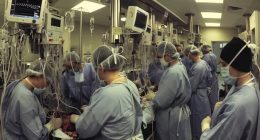Blast lung refers to a kind of injury sustained from a blast wave, typically seen in explosions, like those from bombs or gas explosions. Historically, this condition gained prominence during conflicts, particularly World War I, when soldiers were exposed to artillery explosions. Over time, the medical community identified that these injuries, characterized by damage to the lungs, could cause severe respiratory issues.
Blast lung involves a range of pulmonary injuries, from mild contusions to serious hemorrhage and edema. The blast wave can lead to a rapid increase in air pressure within the lungs, leading to rupture of alveoli and disruption of pulmonary vasculature.
Causes
Blast lung is mainly caused by the shockwave produced from explosions. This shockwave generates a rapid and intense increase in air pressure, which can severely damage the lungs and surrounding tissues. The main causes of blast lung are:
- Explosive Devices: Explosions from grenades, bombs, and other explosive weapons release a powerful shockwave that can lead to a blast lung.
- Gas Explosions: Accidents involving the explosion of gas can create similar shockwaves that lead to lung injury.
- Industrial Accidents: Explosions in industrial settings, like chemical plant explosions, can also result in blast lung injuries.
- Military Conflicts: The use of explosive weapons in combat situations frequently results in blast lungs among civilians and soldiers in the vicinity.
- Terrorist Attacks: Bombings and other terrorist attacks involving explosives can cause widespread blast lung injuries to those in the blast zone.
Treatment
Treatment for blast lung aims to address both the immediate damage and long-term complications resulting from the injury. Initial management includes ensuring the airway is clear and providing supplemental oxygen to assist the patient in breathing more easily.
Intravenous fluids may be administered to maintain hydration and blood pressure, while medications like corticosteroids might be used to decrease swelling and inflammation in the lungs. In severe cases, mechanical ventilation may be necessary to support breathing and handle the pressure in the lungs.
Long-term management of blast lung often needs a multidisciplinary approach, including respiratory therapy to aid in lung recovery and physical therapy to assist with overall rehabilitation.
Regular observation and follow-up care are important to address any persistent symptoms like difficulty breathing and chronic cough. In some cases, surgical intervention may be required to repair significant lung damage or to address issues like hemothorax or pneumothorax. A comprehensive treatment plan aims to restore lung function, enhance quality of life, and mitigate any lasting effects from the blast injury.
Diagnosis
Diagnosing blast lung involves a combination of imaging studies, clinical evaluation, and sometimes advanced diagnostic techniques. Early identification of blast lung is critical due to its potential for serious complications. The diagnosis typically begins with a detailed medical history, aiming at the recent exposure to explosions or high-impact events. Physical examination and sign assessment further guide the diagnostic process.
The main diagnostic approaches include:
- Clinical History and Symptoms: Assessment of signs like difficulty breathing, coughing up blood, chest pain, and a history of recent blast exposure are important for diagnosing blast lung.
- Computed Tomography (CT) Scan: A CT scan provides a complete view of the lungs, assisting to find subtle injuries and assess the extent of lung damage more accurately than an X-ray.
- Chest X-ray: This initial imaging test helps recognize lung contusions, fractures, and other obvious signs of injury. It can reveal abnormalities like pneumothorax or pulmonary edema.
- Ultrasound: In some cases, ultrasound may be used to evaluate pleural space and find fluid build-up or other abnormalities.
- Arterial Blood Gas Analysis: This test measures carbon dioxide and oxygen levels in the blood, which can help assess the seriousness of lung disorders and guide medication decisions.
- Pulmonary Function Tests: These tests evaluate the lung’s ability to move air in and out, assisting in determining the functional impact of the injury and guiding rehabilitation efforts.
Symptoms
The symptoms of blast lung can vary in seriousness depending on the extent of the injury and the force of the blast. Commonly, individuals with blast lung experience immediate and intense respiratory symptoms. These include difficulty breathing, shortness of breath, and a feeling of chest tightness. Patients may also report sharp or aching chest pain, which can be exacerbated by coughing or breathing. Coughing up blood or blood-streaked sputum is another critical symptom that indicates possible damage to the pulmonary vasculature.
In addition to the acute symptoms, individuals may experience more chronic effects as the condition progresses. These can include persistent wheezing, cough, and general tiredness. Severe cases might lead to respiratory failure or issues like pneumothorax (air in the pleural cavity) or hemothorax (blood in the pleural cavity), which can further impair lung function and require urgent medical attention. Observing and managing these symptoms effectively is crucial for preventing long-term problems and ensuring a better recovery outcome.
Prevention
Preventing blast lung involves a combination of safety measures and protective strategies designed to reduce the risk of exposure to explosive forces. In military and high-risk occupational settings, wearing appropriate personal protective equipment (PPE) is important. This includes blast-resistant vests and helmets, which can help absorb and dissipate the impact of shockwaves and decrease the seriousness of injuries. Additionally, training individuals to identify and respond to explosive threats can enhance preparedness and decrease the likelihood of injury. Implementing rigorous safety protocols and regular drills also helps to mitigate risks in environments prone to explosions.
For civilian populations, particularly in areas where industrial accidents or terrorist attacks are a concern, preventive measures include maintaining strict safety regulations around explosive materials and ensuring proper storage and handling procedures. Public awareness campaigns and emergency preparedness programs can also play a role in minimizing the impact of blast-related incidents. In cases where explosive devices are a known threat, staying informed about evacuation routes and safety measures can help individuals protect themselves from potential blast injuries.
Summary
Blast lung results from the shockwave of explosions, causing damage to the lungs and respiratory system. Symptoms include difficulty breathing, chest pain, and coughing up blood. Diagnosis involves clinical history, imaging studies, and pulmonary tests.
Treatment focuses on immediate care, including oxygen support and possibly mechanical ventilation, with long-term management through rehabilitation and monitoring. Prevention strategies include wearing protective gear in high-risk settings and adhering to safety protocols to minimize exposure to explosions. Public awareness and emergency preparedness also contribute to reducing blast lung injuries.









